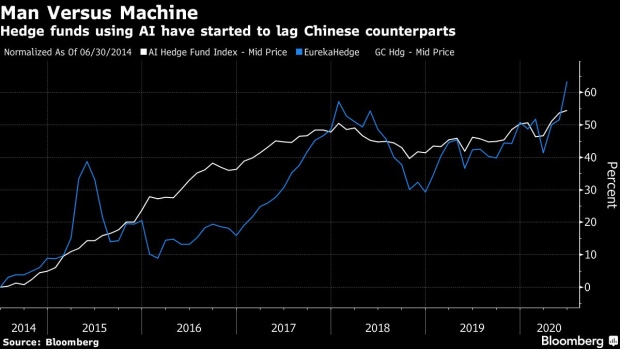(Bloomberg) — A Chinese hedge fund using artificial intelligence to invest in the nation’s stock market expects to exceed $1 billion in assets on growing demand for quantitative investment strategies.
Shanghai MingShi Investment Management has raised $600 million offshore since March and is targeting at least another $400 million in the next few months as current investors ramp up allocations, said Stephan Zhou, a partner at the company. That’s despite the fact that due diligence has become more difficult because of the pandemic, he added.
“China has very good alpha, but it’s not low hanging,” Zhou said in an interview, referring to gains in excess of a market benchmark. “You need to do some serious research before you can get it.”
Homegrown Chinese quant funds are expanding in number and trying to close the technological gap to established players such as D.E. Shaw & Co. and Two Sigma Investments LP. The Mingshi China Optima Master Fund uses deep learning to combine between a few hundred and several thousand factors into trading recommendations, focusing on intra-day to one-month horizons.
The market-neutral Mingshi China Optima Master Fund targets a 15% to 20% return this year, Zhou said. Because of difficulties shorting individual stocks in China, the company sells index futures to achieve a similar effect to traditional market-neutral approaches.
China’s markets have been on a wild ride in recent weeks, delivering the fastest rally since 2014 before slumping after officials signaled unease with the boom. The CSI 300 Index remains about 13% higher this year and trading volumes surged as retail investors jumped in.
“If they trade more, that’s where mispricings and market inefficiencies become more obvious, and we’ll perform better than normal,” Zhou said.
The firm was set up in 2010, when co-founder Yu Yuan and Robert Stambaugh, a finance professor at the University of Pennsylvania’s Wharton School, started a fund to trade China’s A-share market. Stambaugh was Yu’s PhD supervisor.
“It was a wide open frontier in the quant space,” said Stambaugh, now a senior adviser to MingShi. “China offered a great opportunity to apply scientific principles and a very disciplined approach based on academic research.”
The company plans to double research staff to 80, and has them working in separate groups partly to avoid the risk of concentrating too much effort on the same factors.
.
Source:- BNN
Source link
Related
























